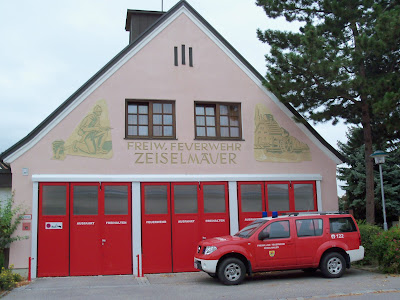The view from the hotel in Greifenstein.
Zeiselmauer, most probably the Roman Cannabiaca, was the most eastern camp of the province of Noricum and served as a garrison of a mixed auxiliary force of 500 horse and foot soldiers (cohors equitata). Originally an earth and timber structure, the camp was rebuilt in stone in the 2nd century. All preserved buildings derive from the late period in the 4th century. Cannabiaca is one the best preserved and documented roman camps at the Austrian Danube Limes.
Late Roman fortress (Burgus) at the north-western corner of the Roman camp. Second half of the 4th century. Access through the archway from the camp's side only. Originally a three-storey building with intermediate wooden ceilings. In the centre, four hook-shaped foundations surround a small inner courtyard. They bore wooden pillars supporting the roof. Unique building of that type in Austria.
Late Roman box-shaped gate replacing the previous eastern camp gate (Porta Principalis Dextra). Second half of the 4th century. The rounded edges of the building characterise the Roman architecture. Used as a granary (Körnerkasten) from the middle ages onwards and therefore well maintained. One of the largest preserved Roman buildings in Austria.
Granary / Eastern Gate Building
Just above the actual ground level one recognizes the upper part of the archway, on the left side, the link to the former camp wall.
Just above the actual ground level one recognizes the upper part of the archway, on the left side, the link to the former camp wall.
Roman walls near the house, something that makes an impression ...
North-eastern corner tower of the Roman camp. Attached to the existing camp wall in the 1st half of the 4th century. Because of its fan-shaped layout it protruded widely from the camp's wall and thus enabled the defenders to make better use of their arms against attacking enemies. in the southern part of the building, the link to the camp's wall can still be seen. Original height of the tower: 9 meters.
North-eastern corner tower of the Roman camp. Attached to the existing camp wall in the 1st half of the 4th century. Because of its fan-shaped layout it protruded widely from the camp's wall and thus enabled the defenders to make better use of their arms against attacking enemies. in the southern part of the building, the link to the camp's wall can still be seen. Original height of the tower: 9 meters.
The holes used for the scaffold derive from the construction time and are marked by wooden poles. The only free standing fan-shaped tower preserved in Austria.
by text: Verein Freunde von Zeiselmauer
Information board with sunflower :)
The next town on the same day is Tulln an der Donau with fountains show.
The roman cavalry fort Comagenis in Tulln
Roman Tower (Römerturm), completely intact tower of the fort Commagenis at Donaulände street.
U-tower also called Salt Tower (Salzturm), architectural details, one of the doors and window.
The Roman Emperor and Emperor Marcus Aurelius Antoninus Augustus. “For the memory of the Roman history of the city of Tulln Roman cavalry camp legion Comagena (…)”
These benches are in Tulln near Roman Museum.
And again, the fountains of Tulln.

















Brak komentarzy:
Prześlij komentarz